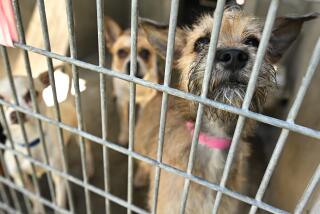Saving Horses From Last Roundup
- Share via
More than 300 horses gambol on a 40-acre desert ranch in a remote corner of the Antelope Valley. But if it weren’t for Linda Moss and her army of volunteers, the horses would have met an entirely different fate--in the slaughterhouse.
“We have a little miracle going up there,” said Moss, who runs a Glendale-based group called Equus Sanctuary.
The Antelope Valley ranch--whose location is a carefully guarded secret--costs more than $30,000 a month to maintain. It may be the largest preserve of its kind in the country.
The ranch had its beginnings 10 years ago when Moss attended an auction of Arabian horses in Pomona. Moss, who loves the breed, was shocked to see meat buyers snap up 38 of the 112 animals being offered for sale.
At that time, the market for horses was glutted. Before federal tax reform in 1986, horse breeding offered myriad tax advantages to investors. Others were drawn by skyrocketing prices for top horses.
But the breeding business took a cold shower after tax reform. Although many legitimate breeders welcomed the change, others suddenly found themselves with a glut of horses, unable to find buyers. The meat dealers began gobbling them up, often turning a quick $50 profit per horse by acting as middlemen for slaughterhouses.
“It was largely very wealthy people who dumped their horses all at once,” said Moss, who gave up her career as a motion picture sound editor to form Equus Sanctuary. “It was just a blood bath.”
Almost 3 million horses have died at a handful of U.S. slaughterhouses over the last 15 years, according to the U.S. Department of Agriculture. Countless others met similar fates, jammed aboard double-decker cattle trucks bound for Canada and Mexico.
“You couldn’t find an inexpensive horse for the kids, or just to ride down the trail. They had all been killed,” said Cathleen Doyle of the California Equine Council of Studio City. “Every horse that sold for less than $1,000 was in jeopardy.”
Slaughterhouses declined to comment.
Growing concerns about horse butchery led to an initiative banning the sale of horses for slaughter. The measure was approved by California voters last fall.
Although the California law--the first of its kind in the nation--makes the sale of a horse for slaughter a felony, equine advocates say that it has not been fully effective.
“You don’t see the double-deckers on Tuesdays shipping horses out by the hundreds any more,” said Gini Richardson, legislative chairwoman of the California State Horsemen’s Assn. “But you do see them moving out by the onesies, twosies and tensies,” showing up at low-end auctions in Arizona and elsewhere.
Doyle and others are now turning their sights to other states, intent on putting the five remaining equine slaughterhouses in this country out of business.
They also want to quash the appetite for horse meat in other countries, including Belgium, France, Italy, Mexico and Japan.
Eating horse meat--or buying it from a slaughterhouse--is legal in the United States, but as a practical matter, there is no domestic market. But the overbreeding of horses supplied a ready demand for meat in the foreign markets.
From 1987 through 1992--the years immediately after the tax reforms--more than 300,000 horses were slaughtered annually in the United States.
In the last two years, the annual number has dropped to fewer than 100,000. Richardson said that is solely because of a dwindling supply.
Horse rescue operations are diversified, but most agree that their motivations are the same.
Moss of Equus Sanctuary and her colleagues look for horses in feedlots. This is where most of the unwanted horses end up. Lot owners sometimes retrain and sell the horses to good homes, but some get shipped out of state to uncertain futures.
The horses Moss buys are retired permanently and supported entirely by donations and teams of volunteers.
Pat Rogers, who launched the Equine Rescue League in 1990, says her inspiration came from a crippled mare that was sold to a meat buyer for $7. Rogers said she told the pathetic animal: “I have no place, no money, no way to get you out of here. But by God, I will do it.”
The league now shelters 49 horses at a time on a 66-acre ranch.
RoseAnn Nemes of Shadow Hills launched her own rescue operation two years ago, the Arabian Horse Rescue Network at www.ahrn.org
Nemes was inspired by one of the first horses she helped pull out of a feedlot, a twentysomething Arabian gelding named Arthur. “I knew instantly that Arthur was the horse that I should have had as a little girl,” she said.
Nemes now rescues two or three horses at a time. The rescued animals, often in poor condition, are restored to health before they are sent off to new homes.
But there is one horse Nemes says she will never part with.
“No one will ever take my Arthur from me,” she said. “Not over my dead body.”






